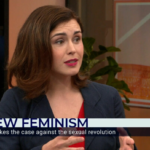The Paid Maternity Leave Debate
Should we institute a scheme of paid maternity leave? I am going to argue neither for the affirmative, nor for the negative. Instead, I will seek to argue for a third way. The third way I propose is fairly straight-forward: I believe that if we are to offer paid maternity leave, it should be available to all mothers, not just to those in the paid work place. I offer four reasons for this:
First, the principles of justice and equity demand that we take this approach. Why should we discriminate against mothers who choose to stay at home? Not only do babies cost a lot of money for all women, whether working or not, but the stay at home mum chooses to forgo income for the sake of the baby and its well being. Thus the woman in the paid work force getting paid leave would be receiving a double set of financial benefits, while the stay at home mum would receive none.
Indeed, one must ask why it is that families with working mothers should be subsidised by families with mothers who choose to stay at home?
It seems that government policy should be neutral in this regard. Governments should not skew the debate by offering financial incentives to mothers to rejoin the work force, while at the same time penalising mothers who choose to stay at home.
We live in an age which puts a high premium on choice. However, in this debate, we are denying many women genuine choice. Mothers should be free to choose whether they stay at home with their children or return to the paid workplace.
But if all the financial incentives are only going in one direction, then we can hardly talk about genuine choice.
Thus the principles of equity and fairness demand that we treat all mothers equally. If governments are going to get into the business of financing motherhood (and I think a strong case can be made for doing that), then they ought to treat all mothers the same, and not favour one over the other.
Secondly, there is a growing body of research to suggest that most mothers do want this kind of choice. Numerous surveys and studies have found that many mothers do in fact prefer to stay at home with their young children, but economic necessity in effect drives these mums into the paid workplace. It is simply too difficult these days to pay the bills and take care of the mortgage on one income. Thus economic conscription, rather than genuine freedom of choice, is driving many mothers into the paid workforce.
Many international studies could be mentioned here. British sociologist Catherine Hakim has done a lot of work in this area. She has capably demonstrated that women should not be squeezed into a homogenous, one-size-fits-all pattern.
Instead, she has found that when it comes to work-and-family issues, British women fall into three groups. One is primarily attached to work and career, another is attached to family and child rearing, while a third group is attached to family and child rearing but wants the option of part-time work.
Australian research suggests that the situation is similar here.
A recent study by the International Social Science Survey shows that by far the largest group in Australia is the one attached to family and child rearing. More than two thirds of Australians believe that mothers of pre-schoolers should not be in the paid workforce.
In the study, 69 per cent of Australians said that being a full-time homemaker was the ideal option for mothers with children under six. And when asked what their personal choice was, 71 per cent of women said they preferred full-time mothering.
Melbourne University’s Dr Mariah Evans and Dr Jonathon Kelley, who conducted the study, said this:
“This data shows that full-time home making is the morally preferred option by most people and it is the one that most women give highest rating to as an option for themselves”.
And a recent survey by the Australian Institute of Family Studies found that 83 per cent of women and 84 per cent of men felt that mothers should not work full-time, even when their youngest child is at school. Almost two-thirds of the respondents felt that families suffered if women work full-time
Thus it is clear that for the majority of mothers with pre-school children, there is a decided preference for family and child rearing. Therefore, any policy which we decide upon should take these very strong preferences into account.
A third reason for making paid maternity leave available to all mothers is a very practical one, especially to business. Studies have shown that offering people real flexibility in the area of work and family makes for better, more productive employees.
When real flexibility is introduced into the workplace, employees become happier and better workers. Conversely, many studies have shown that people with family problems are people with workplace problems.
If employers want to keep their workers contented and productive, they need to do their bit to ensure that family life is a happy and satisfying place to be.
And given that so many families today are facing crises because of work pressures, debt problems, and limited flexibility in the work place, any company that can relieve some of these pressures will find themselves becoming beneficiaries, at least in the long run.
Finally, not only will business benefit from the offer of real choice to mothers, but so too will children and society as a whole.
Once again, the social sciences can offer us a wealth of information in this regard. We know from a growing mountain of social science evidence, that the ideal for very young children is to be able to spend time with their parents, especially mothers. This in turn results in children who seem to do better later in life, by a whole range of indicators. Important socialisation skills and relational abilities seem to best be formed in the home at an early age.
In other words, too much formal day care at too early of an age seems to result, generally speaking, in some negative outcomes for children. The more time children can have at home with mum in the early stages, the better they seem to be for it.
And well adjusted children, for the most part, make for well-adjusted citizens.
Thus any policy which allows mums to have some extra time with baby is in the best interests, not only of the child, and not only of the family, but of society as well.
And what about the costs? How will such a scheme be paid for? Here I am sympathetic to the negative side. Business cannot pick up the whole tab. Small business especially would suffer greatly. Perhaps a mix of government and business support would be appropriate.
If we do pay all mothers, some current expenses would be abolished or lessened. The baby bonus would be replaced, for example. There would be less demand for child care. And unemployment benefits might be lessened.
Obviously some offset costs would incur. We know that family breakdown costs Australia at least $3 billion annually. Part of the cause of family breakdown is work-related. For example, two parents up to their ears in work have little time for each other or for their children.
If fewer family breakups take place because of the greater flexibility offered with a universal maternity payment, we could save money on the other end: that is, on picking up the pieces of marriage and family breakdown. It’s the old principle: prevention is better than cure.
But if governments want something enough, they will find a way. We can find funding for our efforts in East Timor, the war on terror, and our Commonwealth and Olympic athletes. If we are serious about helping young families, we can find some funding here as well.
In conclusion, much of the discussion concerning paid maternity leave seems to centre on businesses getting their female employees back to work as soon as possible. Indeed, many proposed policies appear to be little more than bribes. The implication of the proposals goes something like this: “OK, we’ll give you a few weeks, or a few months off, under the condition that you return to the work place immediately thereafter”.
But mothers do not need bribes. They need real choice. Any government policy which offers real choice will have the support not just of the majority of Australian mothers, but, according to the research, of most Australians.
[1424 words]



















